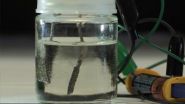(Press-News.org) Citizen scientists are saving the lives of people living in the shadow of deadly volcanoes according to new research from the University of East Anglia.
A new report published today reveals the success of a volunteer group set up to safeguard communities around the 'Throat of Fire' Tungurahua volcano in the Ecuadorian Andes.
More than 600 million people live close to active volcanoes worldwide. The research shows that living safely in these dangerous areas can depend on effective communication and collaboration between volcanologists, risk managers and vulnerable communities.
It is hoped that the research will help inform similar community engagement in volcanic and other disaster risk reduction projects around the world.
The report looks at a 35-strong network of volunteers called 'vigías', which was set up 14 years ago in the wake of renewed activity at a historically deadly volcano. The eruptions led to a military evacuation of around 25,000 people from Baños and the surrounding area. But leaving homes, land and livelihoods was hard, and the community rallied together to over-run checkpoints and re-occupy the town.
Lead researcher Jonathan Stone from UEA's school of Environmental Sciences said: "This pattern of re-occupation is common in volcanic areas and after other natural disasters. The people of Baños wanted to go home even though it wasn't safe.
"The volcano's activity has varied from small explosions with ash emissions to violent eruptions with fast-moving pyroclastic flows. Living close by is a real risk, and so the vigía network was set up to help monitor the volcano and protect the community.
"It was initially a compromise between the community and civil protection agencies who were attempting to ensure their safety."
The Spanish word 'vigía' means watchman, guard, sentinel or lookout - but the research shows that the role extends beyond that which the name suggests and that of the normal citizen scientist.
"The vigías are members of the community who help scientists collect data about volcanic activity, are part of a vital early warning system for eruptions, and facilitate evacuations of the community during a crisis.
"The network enables citizens to continue to live and work in a hazardous area by enhancing their capacity to respond quickly to escalating threats. The ideal risk reduction scenario would be to move people out of the way of the volcano permanently, but clearly this is not always practical - people often want to live and work in particular locations for a number of reasons, and anyway - there are few places that you can move in the Ecuadorian Andes that aren't threatened by one or several volcanoes!
"Community based monitoring has the potential to reduce risk by providing useful data, fostering collaboration between scientists and communities, and providing a way in which citizens are empowered to take actions to preserve lives and livelihoods."
The report reveals how one particular eruption in August 2006 was pivotal, with many lives saved in the Juive Grande area thanks to the vigía network. And when further eruptions took place in 2013 and as recently as February and April this year, scientists and responding agencies attributed in part the zero loss of life and injury to the quick actions of the volunteers.
The research team interviewed vigías, other people in the community and scientists to discover why the network was such a success.
Jonathan Stone said: "The area is potentially becoming more dangerous with villages and grazing lands around the volcano's base particularly at risk. One of the reasons why the vigías network really works is because they have a vested interest to be ready for the next eruptive event. They want to work with the authorities to help their communities.
"Scientists are considered friends and colleagues, which also has a big impact on the success of the network. The vigías act as a bridge between the community and the scientists. The communities are able to more rapidly trust and act upon advice from the scientists and authorities, because of the vigías.
Prof Jenni Barclay from UEA's school of Environmental Sciences leads the Strengthening Resilience in Volcanic Areas (STREVA) project and contributed to the research. She said: "This kind of research is very important because by examining cases like this, we can learn lessons about the potential of community-based disaster risk reduction in other contexts. It provides valuable evidence for how to reduce volcanic risk in practice, which is a critical step in finding ways of increasing society's resilience to events of this nature."
INFORMATION:
'Risk reduction through community-based monitoring: the vigías of Tungurahua, Ecuador' is published in the Journal of Applied Volcanology. The research was funded by the Economic and Social Research Council (ESRC) and the British Geological Survey.
Citizen scientists saving lives around deadly 'Throat of Fire' volcano
2014-08-22
ELSE PRESS RELEASES FROM THIS DATE:
Stanford scientists develop a water splitter that runs on an ordinary AAA battery
2014-08-22
In 2015, American consumers will finally be able to purchase fuel cell cars from Toyota and other manufacturers. Although touted as zero-emissions vehicles, most of the cars will run on hydrogen made from natural gas, a fossil fuel that contributes to global warming.
Now scientists at Stanford University have developed a low-cost, emissions-free device that uses an ordinary AAA battery to produce hydrogen by water electrolysis. The battery sends an electric current through two electrodes that split liquid water into hydrogen and oxygen gas. Unlike other water splitters ...
Genetics and lifestyle have a strong impact on biomarkers for inflammation and cancer
2014-08-22
In a new study published in Nature Communications, research scientists from Uppsala University present for the first time a large-scale study of the significance of genetic, clinical and lifestyle factors for protein levels in the bloodstream. The results of the study show that genetics and lifestyle are determining factors for protein levels, a discovery which greatly influences the possibilities for using more biomarkers to identify disease.
Biomarkers used for diagnosing disease should preferably indicate variations in protein levels only for those individuals who ...
Calcium and reproduction go together
2014-08-22
Stanford, CA—Everyone's heard of the birds and the bees. But that old expression leaves out the flowers that are being fertilized. The fertilization process for flowering plants is particularly complex and requires extensive communication between the male and female reproductive cells. New research from an international team from Stanford, Regensburg, Heidelberg, and Munich, and including Carnegie's Wolf Frommer, David Ehrhardt, and Guido Grossmann reports discoveries in the chemical signaling process that guides flowering plant fertilization. It is published in Nature ...
Fossil arthropod went on the hunt for its prey
2014-08-22
A new species of carnivorous crustacean has been identified, which roamed the seas 435 million years ago, grasping its prey with spiny limbs before devouring it. The fossil is described and details of its lifestyle are published in the open access journal BMC Evolutionary Biology.
The fossils were discovered near Waukesha, Wisconsin, with the new species, Thylacares brandonesis, named after the Brandon Bridge Formation where it was found. It is the oldest known example of the Thylacocephala group - shrimp-like creatures, mostly from the Jurassic period, known for their ...
Climate change could see dengue fever come to Europe
2014-08-22
Dengue fever could make headway in popular European holiday destinations if climate change continues on its predicted trajectory, according to research published in open access journal BMC Public Health.
The University of East Anglia study used current data from Mexico, where dengue fever is present, and information about EU countries in order to model the likelihood of the disease spreading in Europe. They found that coastal regions in around the Mediterranean and Adriatic seas, the Po Valley and North East Italy were most at risk.
Dengue fever is a tropical disease ...
Effort to confront Africa's soil health crisis helps millions of farmers triple yields
2014-08-22
This news release is available in French. NAIROBI (22 August 2014)—With the steady drain of essential nutrients from African soils looming as a major threat to food security across the continent, a new report released today finds that over the last five years, 1.7 million African farmers in 13 countries have embraced farming practices that have rejuvenated 1.6 million hectares and helped them double or even triple crop yields.
The analysis from the Alliance for a Green Revolution in Africa (AGRA) focuses on intensive efforts initiated five years ago to move aggressively ...
Coronary calcium predicts heart disease risk in patients with chronic kidney disease
2014-08-22
Washington, DC (August 21, 2014) — Calcium buildup in the coronary arteries may be a better indicator of kidney disease patients' risk of heart disease than traditional risk factors used in the general population, according to a study appearing in an upcoming issue of the Journal of the American Society of Nephrology (JASN). The findings provide valuable new information that could help safeguard the heart health of patients with kidney disease.
Heart disease is the leading cause of death in individuals with chronic kidney disease (CKD). Some studies have found that conventional ...
Measuring calcium buildup to predict heart disease in those with chronic kidney disease
2014-08-22
Calcium buildup in the coronary arteries of chronic kidney disease patients may be a strong indicator of heart disease risk, according to a new study in the Journal of the American Society of Nephrology (JASN). Researchers at the Johns Hopkins Bloomberg School of Public Health assert that coronary calcium outperforms two other commonly used measures of subclinical atherosclerosis in predicting the risk of heart disease among individuals with kidney disease.
Approximately 50 percent of all patients with chronic kidney disease (CKD) die from cardiovascular disease, but ...
Playing hunger games: Are gamified health apps putting odds in your favor?
2014-08-22
For many people, finding motivation to exercise is a challenge. Thankfully, there are Zombies chasing you.
At least that's the approach of Zombies, Run!—one of more than 31,000 health and fitness apps on the market today, and one of the growing number of apps that use games to increase physical activity.
Gamification is currently the popular trend for mobile fitness app makers looking to cash in to help people get fit. Whether or not it's the best way to exercise remains to be seen.
"It's just been assumed that gamified apps will work, but there has been no research ...
TeleStroke units improve stroke care in underserved areas
2014-08-21
Using telecommunications to connect stroke experts to stroke patients in rural areas continued to improve and sustain stroke care, according to new research in the American Heart Association's journal Stroke.
This is the largest and longest evaluation of telemedicine for stroke and took place in rural Bavaria, Germany.
With the tele-medical linked Stroke Units, patients in regional hospitals had around-the-clock access to consultations with vascular neurologists at stroke centers, including evaluation of brain imaging and patient examination via videoconferencing when ...




